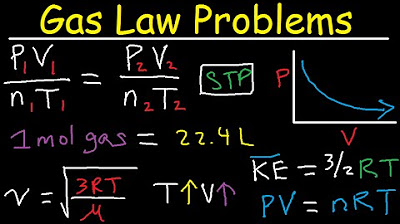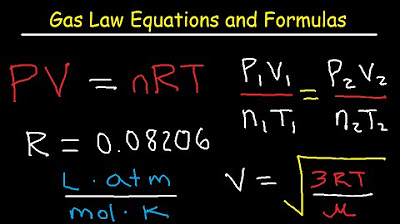Boyle's Law | Respiratory System
TLDRBoyle's Law explains the inverse relationship between the volume of a container and the pressure of the gas within it. Clinically, this principle is crucial for understanding respiration. When the volume of the thoracic cavity increases during inhalation, the pressure inside the lungs decreases, causing air to flow in. Conversely, when the volume decreases during exhalation, pressure increases, pushing air out. This gas movement is driven by the pressure gradient, always moving from high to low pressure.
Takeaways
- 📜 Boyle's Law states that there is an inverse relationship between the volume of a container and the pressure of the gas within it.
- 🔄 When the volume of a container increases, the pressure decreases, and vice versa.
- 📊 Graphically, a container with a piston and gas particles illustrates how pressure changes with volume.
- 💡 Pressure is defined as the force exerted by gas molecules on the walls of their container.
- 📉 Decreasing the volume of a closed container increases the pressure due to more frequent collisions of gas molecules with the walls.
- 🚀 Pushing down on a syringe (closed container) increases the pressure and forces gas out, demonstrating pressure moving from high to low concentration.
- 💥 The respiratory system can be compared to a syringe, with the diaphragm and intercostal muscles controlling volume and pressure.
- 🏃♂️ Inhalation occurs as the diaphragm contracts, increasing thoracic cavity volume and decreasing pressure, causing air to flow into the lungs.
- 🏃♀️ Exhalation happens when muscles relax, decreasing the volume and increasing pressure, pushing air out of the lungs.
- 🔄 The external intercostal muscles further aid in increasing thoracic volume during inhalation, enhancing the pressure differential.
- 📉 During exhalation, the pressure inside the lungs becomes higher than outside, pushing air out according to Boyle's Law.
Q & A
What is Boyle's Law?
-Boyle's Law states that for a fixed amount of gas at a constant temperature, the volume of the gas is inversely proportional to the pressure. In other words, as the volume of a container increases, the pressure within that container decreases, and vice versa.
How does Boyle's Law relate to respiration?
-Boyle's Law is clinically relevant in respiration because it explains how the pressure changes within the lungs during inhalation and exhalation. When the volume of the thoracic cavity increases (during inhalation), the pressure inside the lungs decreases, causing air to flow in. Conversely, when the volume decreases (during exhalation), the pressure inside the lungs increases, pushing air out.
What happens when the volume of a container decreases while the gas particles remain the same?
-When the volume of a container decreases with the same number of gas particles, the particles have less space to move around. This leads to an increased likelihood of collisions between the particles and the container walls, which results in an increase in pressure within the container.
How does pressure in the context of Boyle's Law relate to the movement of gas particles?
-Pressure in Boyle's Law context refers to the force exerted by the gas particles as they collide with the walls of their container. The more frequent the collisions, the higher the pressure. When the volume is decreased, the collisions become more frequent, thus increasing the pressure.
What is the role of the diaphragm in the respiratory process?
-The diaphragm is a skeletal muscle that plays a crucial role in the respiratory process. During inhalation, the diaphragm contracts and flattens, increasing the volume of the thoracic cavity and decreasing the pressure inside the lungs, which allows air to flow in. During exhalation, the diaphragm relaxes and returns to its dome shape, decreasing the volume and increasing the pressure, which forces air out of the lungs.
How do the external intercostal muscles contribute to respiration?
-The external intercostal muscles line the ribs. When these muscles contract, the ribs move upward and outward, further increasing the volume of the thoracic cavity. This decreases the pressure inside the lungs even more, leading to a greater pressure differential between the inside and outside of the lungs, and causing more air to flow into the lungs during inhalation.
What is the significance of the pressure gradient in gas movement?
-The pressure gradient is the difference in pressure between two areas. Gas moves from areas of higher pressure to areas of lower pressure. This principle is fundamental in understanding how we breathe; during inhalation, the pressure inside the lungs is made lower than the atmospheric pressure, causing air to flow into the lungs.
How does Boyle's Law help explain the process of inhalation?
-Boyle's Law helps explain that during inhalation, the expansion of the thoracic cavity (increased volume) leads to a decrease in pressure inside the lungs. This lower pressure inside the lungs compared to the outside atmospheric pressure allows air to flow in, filling the lungs with oxygen.
How does Boyle's Law help explain the process of exhalation?
-During exhalation, the thoracic cavity volume decreases, which according to Boyle's Law, leads to an increase in pressure inside the lungs. This higher pressure forces the air out of the lungs and into the atmosphere.
What is the relationship between the volume of a container and the pressure of the gas within it according to Boyle's Law?
-According to Boyle's Law, there is an inverse relationship between the volume of a container and the pressure of the gas within it. As the volume increases, the pressure decreases, and as the volume decreases, the pressure increases, assuming the temperature and the amount of gas remain constant.
How does the concentration gradient affect gas movement in the body?
-The concentration gradient affects gas movement in the body by dictating the direction of gas flow. Gas will move from areas of higher concentration (higher pressure) to areas of lower concentration (lower pressure). This principle is evident in both inhalation, where air high in oxygen concentration enters the lungs, and exhalation, where air high in carbon dioxide concentration is expelled.
Outlines
📚 Boyle's Law and Its Clinical Relevance in Respiration
This paragraph introduces Boyle's Law, explaining its principle of an inverse relationship between the volume of a container and the pressure of the gas within it. It uses a syringe filled with oxygen molecules as a visual aid to demonstrate how decreasing the volume of the container increases the pressure, leading to more frequent collisions of gas particles with the container walls. The clinical relevance is then introduced by drawing a parallel between the syringe and the respiratory system, emphasizing how changes in pressure facilitate the inhalation of air due to the movement of gas from areas of high pressure to low pressure.
💪 The Role of Muscles in Boyle's Law and Breathing
The second paragraph delves into the physiological application of Boyle's Law in the human respiratory system. It describes how the contraction of the diaphragm and external intercostal muscles increases the thoracic cavity's volume, thereby decreasing the pressure inside the lungs. This pressure differential allows air to be drawn into the lungs. The paragraph also explains that the more muscles involved in increasing the thoracic volume, the greater the amount of air inhaled. Conversely, when these muscles relax, the volume decreases, and air is expelled from the lungs, illustrating the direct impact of Boyle's Law on the mechanics of breathing.
Mindmap
Keywords
💡Boyle's Law
💡Respiration
💡Pressure
💡Volume
💡Inversion Relationship
💡Gas Particles
💡Thoracic Cavity
💡Diaphragm
💡Intercostal Muscles
💡Concentration Gradient
💡Clinical Relevance
Highlights
Boyle's Law states that the volume of a container and the pressure of gas within it have an inverse relationship.
As the volume of a container increases, the pressure within that container decreases, and vice versa.
The shorthand representation of Boyle's Law is that increasing the volume results in a decrease in gas pressure, and decreasing the volume increases pressure.
The pressure of gas in a container is a measure of the force exerted by the gas molecules on the container walls.
When the volume of a container is decreased, the gas molecules have less space to move, increasing the likelihood of collisions and thus increasing pressure.
Pressure always moves from an area of high pressure to an area of low pressure, which is a fundamental principle in understanding Boyle's Law.
In a closed container with a piston, pushing down on the plunger decreases the volume and increases the pressure, causing gas to be forced out.
The respiratory system can be compared to a syringe in terms of Boyle's Law, with the lungs being the container and air being the gas.
When the diaphragm contracts and moves down, it increases the volume of the thoracic cavity, decreasing the pressure inside the lungs.
The external intercostal muscles contracting further increases the thoracic cavity volume, enhancing the pressure differential and allowing more air to be inhaled.
The relaxation of respiratory muscles decreases the volume of the thoracic cavity, increasing the pressure and pushing air out of the lungs.
Boyle's Law has clinical relevance in understanding how changes in lung volume affect the pressure and flow of gases during respiration.
Gas exchange in the lungs is driven by the pressure differential between the inside of the lungs and the outside atmosphere, as per Boyle's Law.
The force exerted by gas molecules on the walls of the lungs is what facilitates the process of inhalation and exhalation.
Understanding Boyle's Law is crucial for comprehending the mechanics of breathing and the function of the respiratory system.
The application of Boyle's Law in medicine helps in the development of respiratory therapies and the management of lung conditions.
Boyle's Law provides a fundamental principle that explains the physical basis of how we breathe and the movement of gases in and out of our lungs.
Transcripts
Browse More Related Video

Introduction to partial pressure | Gases and kinetic molecular theory | Chemistry | Khan Academy

Temperature: Crash Course Physics #20

Ideal gas equation example 2 | Chemistry | Khan Academy

Gas Law Problems Combined & Ideal - Density, Molar Mass, Mole Fraction, Partial Pressure, Effusion

Gas Laws - Equations and Formulas

The Ideal Gas Law: Crash Course Chemistry #12
5.0 / 5 (0 votes)
Thanks for rating: